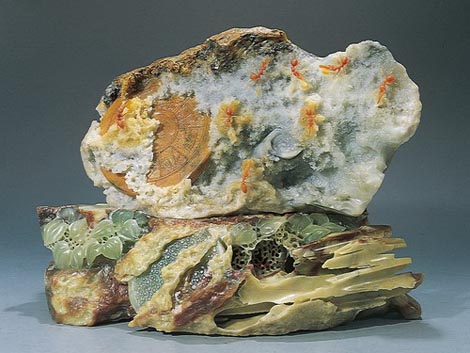Xiuyan jade carves out place within nation’s artistic traditions

A Xiuyan jade carving on display
Four places in China are famous for producing jade: Hetian Prefecture in Xinjiang Uyghur Autonomous Region, Dushan County of Nanyang City in Henan Province, Xiuyan Manchu Autonomous County in Liaoning Province, and Lantian County of Xi’an in Shaanxi Province. Xiuyan jade is well-known for its usage in ancient jade objects excavated in historical sites, including the most renowned jade dragon of Hongshan Culture.
The intricate jade carvings by craftsmen from Xiuyan in particular show their advanced skills.
Xiuyan jade carving originated during the period of Emperor Qianlong (1711-99), and flourished during the reign of Xianfeng (1831-61) in the Qing Dynasty (1616-1911). At the end of the Qing Dynasty, a street of prosperous jade crafts and businesses formed within the county, with over 300 jade craftsmen working there.
Xiuyan jade carvings are mainly suhuo, figures, flowers, birds, and other animals. Suhuo, the most representative work of this craft, is a cover term for decorative carvings on furnaces, bottles, dings, pots and other ancient vessels for display. Most of them were modeled on bronze items used before the Qin (221–206 BC) and Han (206 BC- AD 220) dynasties.
The technique of Xiuyan suhuo is even praised by experts of other schools of jade carving. In relation to the difficulty of the technique, Wang Yunxiu, master of the Xiuyan jade suhuo technique and its national-level inheritor, said one source of difficulty comes from the requirements for shape and color of raw material. Most suhuo works are round or square, meaning that much of the raw material is wasted. The whole piece of jade must be of the same color and without variegated flaws. The second is the amount of time required to produce a piece of work. Usually, it takes several months or even more than one year to finish one item. The last is the demand for high skill in the actual carving process. For example, there can be dozens of rings interlinked on one piece of work. One mistake can spoil the whole piece.
The many difficulties of carving these items and high standards for skills of craftsmen served as a barrier to entry in the profession. Moreover, suhuo objects were not favored in the market. Therefore, many craftsmen changed their preferences and made other kinds of jade objects. This craft was for some time on the verge of being lost. It was not until the beginning of the 20th century, when Wang’s suhuo work The Hall of Prayer for Good Harvest was awarded with the Tian Gong prize, the highest prize for jade carving and stone carving in China, people began to take notice of the value and vitality of Xiuyan suhuo works.
In 2006, Xiuyan jade carving was listed as part of the First National Intangible Cultural Heritage, after which suhuo works, which used to just be known by few people, became a popular artwork on the market. Some of the works could sell for tens of thousands of yuan or even hundreds of thousands of yuan. In addition to locals, many people from Heilongjiang, Jiangsu, Sichuan, Guangxi and other provinces came to Wang to learn the craft. This craft managed to sustain itself.
In 2013, Wang himself built a base for Xiuyan jade carving in the county, where he set up exhibition halls, studios, teaching and research offices, dormitories, dining areas and other facilities. It offers accommodation to trainees from other places.
Now, Xiuyan jade carving is spreading its influence. But we should not be satisfied with just establishing a kingdom of jade carvings. We should nurture craftsmen, because this kind of inheritance is the key to sustaining intangible cultures.
